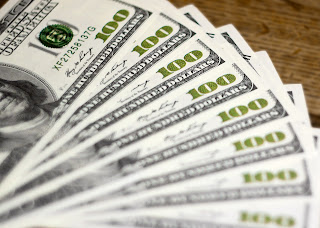8 Ways to Spot a Counterfeit Bill
Everyone loves a stash of cash — unless it’s fake. Unfortunately, there’s been a surge in the spread of counterfeit bills during the coronavirus pandemic. Bogus bills can be difficult to spot. Here are some signs to help you determined if it’s the real thing:
A hologram of the face image on the bill: When held up to the light, the hologram on the bill should match the face on the front of the bill. Scammers will often bleach a lower denomination bill and try to pass it off as a bill of a higher denomination — but they can’t change the interior hologram. Check to make sure the face matches the one in the center of the bill to be sure it’s authentic.
A thin vertical strip of text spelling out the bill’s denomination: Holding the note up to the light will also display this sign of authenticity on genuine bills.
Color-shifting ink: All new-series bills, except for the $5 bill, were designed with this trick: If you tilt the bill back and forth, the numeral in the lower right hand corner will shift from green to black and back to green again.
Watermark: The watermark of the bill can be seen in an unprinted space to the right of the portrait when the bill is held up to the light.
Security thread: Also apparent when the bill is held up to light, the security thread is a thin strip running from the top of the face on the bill until its bottom. The security strip is positioned to the right of the portrait on $10 and $50 bills, and to the left of the portrait on $5s, $20s and $100s.
Ultraviolet glow: You’ll need an ultraviolet light for this to work, but it’s an instant reveal about the bill’s authenticity. When held up to an ultraviolet light, $5 bills glow blue, $10 bills glow orange, $20 bills glow green, $50 bills glow yellow, and $100 bills glow red.
Microprinting: For yet another sign of a bill’s authenticity, you can look for tiny microprinting on the bill’s security thread, which spells out its denomination in all-caps text.
Fine line printing patterns: Look for very fine lines behind the portrait and on the other side of the bill as well.
What to do if you’ve been passed a counterfeit bill
- Do not put yourself in a position of danger.
- Do not return the bill to the passer.
- If possible, delay the passer with an excuse.
- Take note of the passer’s physical appearance and record their vehicle license plate if possible.
- Contact your local police department or call your local Secret Service office.
- Write your initials and date in the white border area of the suspected counterfeit note.
- Do not handle the counterfeit note. Place it inside a protective cover, a plastic bag or an envelope until you can pass it on to an identified Secret Service Special agent. You can also mail it to your nearest Secret Service office.
Counterfeit cash can be harder to spot than you think. Don’t get stuck holding the bag! If you think you’ve been passed a counterfeit bill, and the note is missing the signs listed above, follow the advice of the U.S. Treasury to keep your hands clean.
Your Turn: Have you ever encountered a counterfeit bill? Tell us about it in the comments.
« Return to "Money Matter$ Blog"





